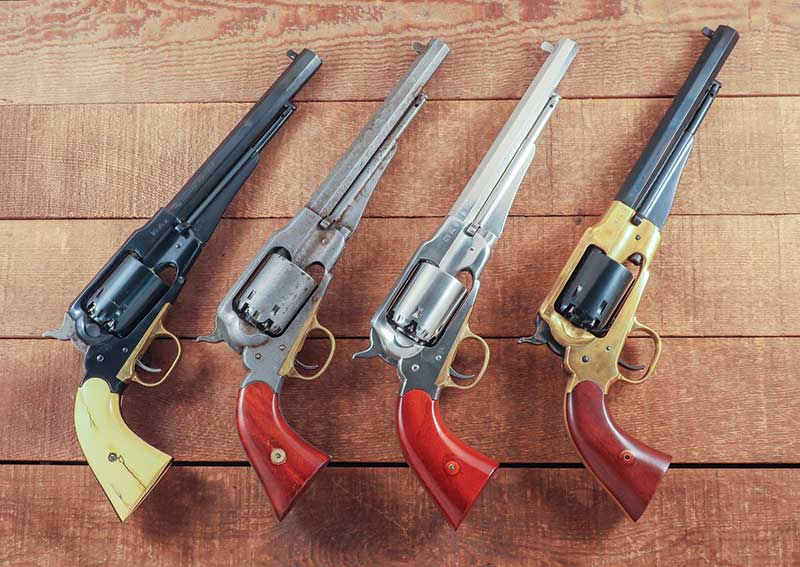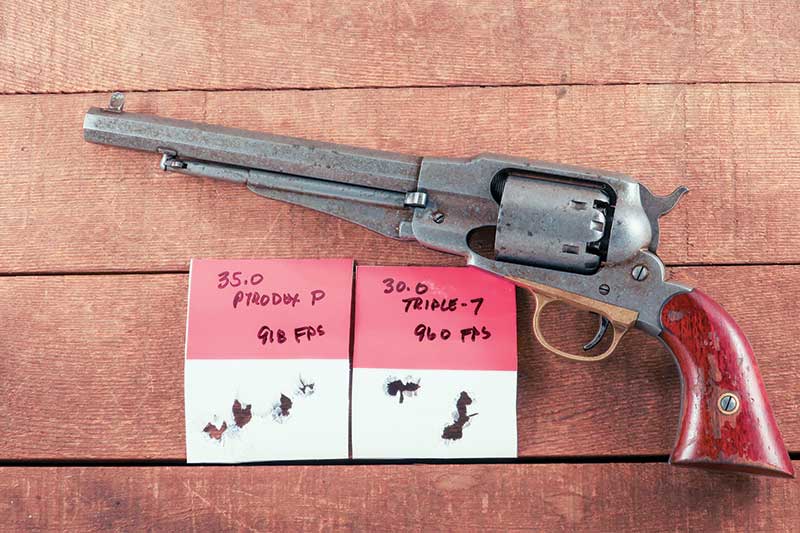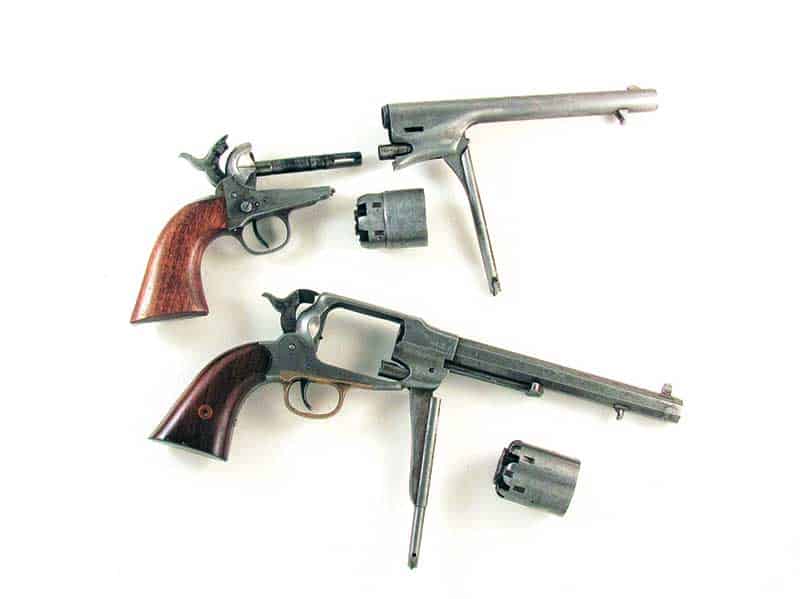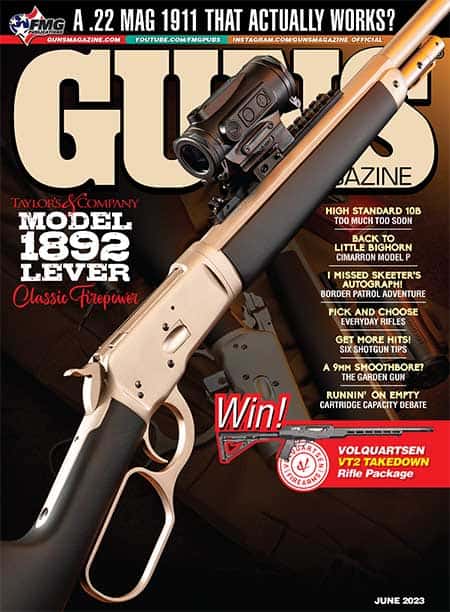Remington Sixguns Part I:
The Percussion Era
Sam Colt brought forth the first successful repeating firearm with the five-shot Paterson in 1836. Remington goes back even farther than Colt. Two years after Sam Colt was born, Eliphalet Remington was already in the gun business supplying custom guns and parts. By 1845, E. Remington & Son furnished 5,000 rifles to the United States Army and 10 years later Remington acquired Fordyce Beals as a partner.
Beals was directly responsible for Remington’s lineup of sixguns and the first solid-frame revolver was the Remington Beals Model of 1858 in both .36 and .44 calibers. In 1854, Fordyce Beals had joined Whitney Arms designing pocket revolvers and then in 1856, he returned to Remington. One year later Colt’s patent of 1836 ran out and from the late 1850s into the mid-1860s, the Whitney Navy Revolver was produced.
Going Big
Now it was time for Remington to look to full-size sixguns and in 1858 a patent was received for the Beals design. Remington’s cap-and-ball sixguns, with their one-piece design featuring a solid grip frame and a permanently mounted barrel, are certainly stronger than the Colt’s. Colt’s design has a removable barrel held in by a wedge pin and a two-piece grip frame that could easily be removed from the main frame. It is obvious the Colt designers took a strong look at Remington’s design before creating the Peacemaker of 1873.
With a few modifications, the Beals Model of 1858 became the 1861 and 1863 Models. Most Remington replicas today are classified as Model 1858s when they are actually Model 1863s. The Model 1858 had a frame parallel to the cylinder face at the front of the cylinder, thus hiding the barrel threads. The 1863 and today’s replicas do not.
The cylinder of the Colt cap-and-ball pistols rides on a frame-mounted cylinder pin with the barrel held in place by a wedge pin through the front of the cylinder axis pin. Yet Remington’s design is much the same as today’s single-action sixguns with a removable cylinder pin through the front of the frame. Rather than using a spring-loaded or screw-secured locking device, Remington’s cylinder pin is held in place by the loading lever. It is obvious this part of the design of the Remington was “borrowed” from the Whitney revolver.
All in all, the Remington is a much better basic design than the Colt but it does have its drawbacks as the looser Colt would shoot longer without becoming bound up by black powder fouling. Some replica Remingtons I have shot without lube will not make it through a full cylinder without binding seriously, so lubrication is very important here. Both Remington and Colt are also susceptible to jamming from fired cap. This problem can be easily addressed on both models.
Bargain Bin
In spite of the problems, more than 125,000 Remington revolvers were purchased by the government during the Civil War at a price of $4 to $5 less than the Colt 1860 Army.
There may have been a good reason the Remington, which appeared to have the better design, sold for less. Apparently Remington did not have it all together when it came to metallurgy and manufacturing. During Army trials of Remington revolvers in 1867, 40 of the .44-caliber sixguns were fully loaded with six rounds each and out of the total of 240 rounds, 90 failed to fire. The failures were the result of weak mainspring, the hammer not reaching the cap completely or both. Again, problems that are easily addressed today.
The Army inspector also reported burst cylinders being common as were poor quality stocks and slag being found in the main frames. Most of the problems could be corrected with some competent gunsmithing; however, the quality of steel had to be addressed. One thing for certain, there was no way to change the fact the Colt sixguns simply balanced better, felt better and pointed so naturally.
The Remington sights, with a hog wallow in the top of the frame mated up with an easy-to-see front sight, were ahead of their time. It’s the same setup found on the Colt SAA and Ruger Vaquero today.
The Remington sixguns are easy to handle and if one so desires, they are safe to carry fully loaded with six rounds as all Remington replicas have notches between cylinder chambers for the hammer to rest within. As with all percussion revolvers, recoil is very mild with both the .44-and .36-caliber Remington versions. Thanks to their sight set-up, Remington revolvers are relatively easy to sight-in for serious shooting.
Most Remingtons I have experienced shoot 2″–3″ low. Some judicious filing of the front sight solves this. Windage is also easy to correct as the front sight is mounted on the barrel in a dovetail and can be tapped to the right or left to adjust the point of impact.
Originally, the .36 Remington was slightly smaller than the .44 Remington but probably due to manufacturing considerations, both are now built in replica form on the same size frame. Even though it is now labeled the “1858 Remington,” a more correct title would be the “New Model Army.” However, the 1858 name is pretty thoroughly entrenched and I probably use it more than the correct term.
Today
Both Pietta and Uberti offer the standard 8″ New Model Army .44 Remington in blue or antique finish and also with a brass mainframe. The 8″ version is also available with target sights. When it comes to target sights, I definitely prefer those from Pietta with their square notch rear matched up with a post front sight, rather than the Uberti rear sight that has a wide V-notch.
The 1858 Remington is also available with a 5 1/2″ barrel, making it much easier to pack and falling into the category of Percussion Perfect Packin’ Pistol. This one is offered with a full blue finish, blue with a case-hardened frame or full brass frame. The latest offering is the Ace with a 3″ barrel and no loading lever. Since the loading lever is used on all the other models to secure the base pin, this one has a somewhat ingenious lever locking the base pin in place. This very easy packing model is reminiscent of the old “Destroying Angels” and “Avenging Angels” of the 1850s–1860s.
If one looks at the paper ballistics, the .36 numerically speaking as to muzzle energy ranks with the .32 ACP, while the .44, at best as a .38 Special +P. That is only on paper and I don’t buy it! Muzzle energy figures are just that, figures on paper. They do not take into account the alloy of the bullet, shape of the bullet and bullet diameter. Both the .36 and the .44 in reality will leave these more modern cartridges choking in their dust.








